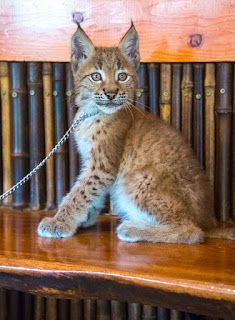Unlike other parks, this is a small walk-through facility that for the most part, raises hand fed babies. Although my preference would be for these guys to be in huge condos out in the wild somewhere, these animals have all been raised in captivity. Their babies, and babies from other zoos, are hand raised in the keepers homes, just like your puppy or kitty. Upon return to the zoos, they make wonderful examples of why we should work harder to keep them alive in the wild.
This huge lion kept tracking something overhead. Although I looked up, I didn't see anything, but am guessing there was a big bird in the tree. These animals never lose their natural instincts, even when hand fed. They are always looking for that next meal.
It was a little early for lions ... they are NOT early risers. Noon probably would have been a much better time to get up.
Maybe he was just showing off his canines for the neighboring lioness. There apparently was something in the air that he didn't like, because he immediately walked around like the regal King he is and sprayed everything in site. Yes I got pictures ... no I'm not showing them.
The Queen of the Day was next door. Every so often you could hear loud huffing going on. I think the King was trying to impress his Queen.
It didn't work. She was just as bored as he was!!
So who's got the bigger teeth? I could have sat and watched them all day, but the tigers had just crawled out of bed too.
If you come around 10:00, they are usually up and roaming around, ready to eat. In the afternoons, they lay out in the sun and do what we would do ... nap.
This white tiger is actually the same as the Bengal tiger. If a baby inherits a recessive gene from each parent, it will be white. Otherwise, it will look just like the big guy above. Several babies have been born here, all hand fed and exchanged with zoos for other babies.
The same is true for leopards. The female here is black ... a recessive gene. The male looks like the leopard you expect, covered in spots. At 21 years old, she has had several sets of babies, either two black or two spotted at a time. Unfortunately, they didn't come out to play.
There's SO much more to see, including capybaras, American bison, camels, the biggest elk I've ever seen, and lots more "kitties". Unfortunately, this time of year is when the birds lose their brilliant feathers, so the peacocks were a little lacking in beauty.
This is the latest Eurasian Lynx baby. Native to Siberia, Asia and Europe, she is just 8 weeks old. She doesn't even have a name yet, so if you've got a good idea, let me know and I'll pass it on. About 12 inches tall, she's still learning how to manage those long legs.
Obviously she loves her "dad". This nice guy takes all of these babies to his house where he litter box trains them and raises them to maturity. He does play with them (with what else, a feather on a stick) but doesn't allow them to bite or attack him or his pant legs. I want his job!!!
She is very similar to the Canadian Lynx that you are more likely to see in Washington or Canada ... or here. Lexi is the lynx I held on my lap and petted last year. You won't believe how she's changed.
To keep from having hundreds of pictures (I took 300 on this day), I'll show you Lexi tomorrow, along with Yari, Bonnie, Roscoe and Ruckus. You're gonna love them!!!













Great pictures of these animals that seem better behaved then your neighbour's dog.
ReplyDeleteAnimals that are kept in captivity have longer life spans then those in the wild. Those in the wild are always exploring their surrounding areas keeping them very active. How long does it take to explore an area they pace five or more times a day.
Be Safe and Enjoy!
It's about time.
Thank you ... they WERE better behaved! LOL
DeleteWhat a wonderful place to visit and love your awesome photos.
ReplyDeleteIt's one of the only places you can get up close and personal with these magnificent creatures.
DeleteMy granddaughter use to work there.
ReplyDeleteI bet she loved it Betty! I'm thinking about volunteering next year.
Delete